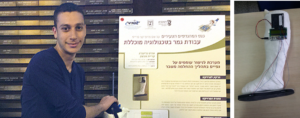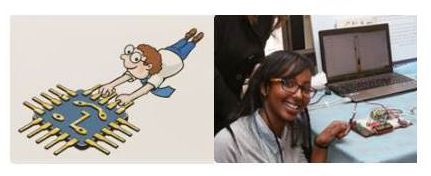What is this special event?
The brainchild of Israel Sci-Tech Schools Network, this national Young Engineers competition draws participants from both our own and other schools countrywide. In their last two years of high school, high school students research scientific and technological needs then design an innovation of their own to meet that need.
 The competitors
The competitors
- We usually host around 200 grade 12 students and another 300 grade 9 students.
- These participants are from about 18 schools, half Israel Sci-Tech Schools and the other half from Ministry of Education schools.
- The enthusiastic teenagers produce about 55 projects in categories like robotics, aides to people with limited mobility and technological solutions to ecological problems.
Why did Israel Sci-Tech Schools Network initiate the national Young Engineers Competition?
Firstly, did you know that…
- Science and technology are Israel’s most developed sectors. In fact, Israel ranks second in the world in the amount of its GDP spent on scientific and technological inquiry.
- Israel is a major contributor – locally and internationally – to developments in aerospace engineering, agricultural engineering, computer engineering, hydraulic engineering, military engineering . . . the list goes on.
- Israel’s science and technology development has been so successful due to the large number of engineers and scientists, far higher per capita than the USA and Japan.
But! Israel’s well-known reputation as the Start-up Nation relies on a steady stream of smart, creative high school graduates ready to tackle the kinds of jobs that will be around in the future. Yet there is a shortage of engineers in Israel. In short, we need geeks!
This is why we organized the Young Engineers Competition and developed i-STEAM education, which combines Innovation, Science, Technology, Engineering, Arts and Mathematics. It is a leap forward from traditional STEM (Science, Technology, Engineering and Math) education.
Look at these innovations from our students at the last few years’ Young Engineers Competition.
Firefighters’ Navigational App
By Bustan El-Marj Sci-Tech School, Bustan El-Marj

Roa Omri, Maaser Zohabi and Tamim Zohabi invented a Smartphone App to help firefighters navigate to the scene of a fire. Precious time is lost when firefighters need to search for the nearest fire hydrants and water supply pipes. This App rapidly collects information about the location of the fire hydrants and pipes closest to the site of a fire, then directs firefighters on the fastest route to hook up to them.
Wheelchair with Built-in Ramp
By Tsimtbaum Sci-Tech School, Arad

Wheelchair-bound people seeking to be as independent as possible are often frustrated by obstacles in their environment. Stairs are one such problem – and the products available on the market to ramp a wheelchair up stairs are costly and inaccessible to the wider population in developing countries.
Along came our Tsimtbaum Sci-Tech team, Inbar Nesi, Michelle Lieberman, Alice Klimovitski and Ohad Agadi with an automatic, removable ramp attached to the wheelchair. It is inexpensive, easy to use and can be attached to most wheelchairs.
When confronted with stairs, at the push of a button, a ramp comes down from each side of the wheelchair, lays itself neatly in front of the wheelchair and allows the user to roll up the stairs.
Load-Monitoring System for the Healing Process in Limb Fractures
Greenberg Sci-Tech School, Kiryat Tiivon
When a person has a leg fracture, the doctor instructs him to put a certain amount of pressure on the plaster cast when walking. This actually reduces recovery time. However, the doctor cannot explain how much pressure to put on the leg, nor can the patient know if he is putting too much or too little pressure on the leg.
Greenberg Sci-Tech students Shachar Ein Kedem (below) and Bar Arma designed a system which sends feedback to the patient and enables him to put a measured amount of pressure on the leg and allows for speedier recovery.
The students worked with the pediatric department of the Children’s Hospital, researching the anatomical and physiological aspects of recovery from a fracture, and the technology needed.

Jet pilots know the dangers of g-force – the rush of blood causing a shock to the senses as they blast out of the bounds of gravity, precious seconds of danger as they lose consciousness and lose control of their jet. Trust our enthusiastic young engineers to engineer a model to prevent this! Their inventiveness and skill was on display.
 A student proudly displays her team’s solution to the effect of g-force on jet pilots.
A student proudly displays her team’s solution to the effect of g-force on jet pilots.
Now that they have solved the jet pilot’s g-force problem, our students solved another one. What happens when someone injures a leg or arm with no access to a nearby emergency room? Again, our young engineers come to the rescue with their sensible, portable x-ray machine for arms and legs!
 A smart solution from this team – their portable x-ray machine can be carried to a medical scene and provide instant results.
A smart solution from this team – their portable x-ray machine can be carried to a medical scene and provide instant results.
What can parents do to prevent an accident when mischievous teenagers sneak away with the family car and take their alcohol experimentation too far? No trouble at all if your car is fitted with a device that detects alcohol in the car, and a drunken driver, and remotely jams the car so they can’t drive!
Other students focused their efforts on the environment. Plastic bottle recycling bins sit brightly around Israel – but how to get people to use them? One young engineering team is a step ahead, designing a basketball style hoop over the container – aim, shoot, and your score is clocked up on a digital reader. Now better that score, and bring your friends to compete too – a win-win!

This project makes recycling plastic bottles a game
People with disabilities also caught our students’ attention. A group of girls designed a walking stick for the blind with built-in sensors.
It beeps faster and faster as one approaches an obstacle too closely – much like the warning sensors on the back of a car helps with reversing safely.
“Our students consistently excel in national and international exhibitions and competitions,” said Zvi Peleg, Director-General of Israel Sci-Tech Schools. “They are passionately engaged in their projects. Our teachers and parents don’t have to nag students to do their homework!”
“This is a clear reflection of the education they receive and their personal ambition that leads them to achieve and contribute. We are extremely proud of their accomplishments at the Young Engineers Conference.





Comments are closed.